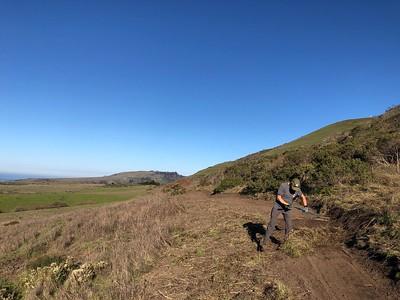BLM and partners break ground on Cotoni-Coast Dairies recreational trails
Organization:
BLM Office:
Media Contact:
SANTA CRUZ, Calif. – The Bureau of Land Management (BLM) Central Coast Field Office and the Santa Cruz Mountains Trail Stewardship (SCMTS) have begun developing the initial 19 miles of multiple-use trails in the Cotoni-Coast Dairies unit of the California Coastal National Monument north of Santa Cruz in Santa Cruz County.
“The BLM is excited to partner with SCMTS in a community effort to provide public access on this magnificent North Coast property,” says BLM Central Coast Field Manager Ben Blom. “These trails will offer new outdoor experiences and help the public connect with nature, while enjoying stunning ocean views, as they recreate on America’s public lands.”
“This is a historic moment for recreation and conservation in Santa Cruz. These trails will go a long way in meeting public demand for outdoor access, and we’re incredibly proud to bring nearly 30 miles of brand-new sustainable trails to visitors of all user types and skill levels,” said Santa Cruz Mountains Trail Stewardship Executive Director Matt De Young. “This is a once-in-a-lifetime project, and our team couldn’t be more excited to bring together the community, as we dig into the future of local trails out at Cotoni-Coast Dairies.”
The area will provide nearly 30 miles of hiking, horseback riding and biking trails, offering a unique recreational experience showcasing world-class views of the Pacific Ocean. These trails will be built by the professional SCMTS trail crew with support from the BLM and community volunteers.
Construction of the new trails will be done in two phases. New routes will be designed using the best practices of modern trail building. Sustainable trail design considers grading, trail width and the effects of high-volume use. The BLM’s trailheads and parking areas will be universally accessible to users of all skill levels with some trails ADA accessible. Trails will become increasingly challenging farther from the property’s entrances. E-bikes and leashed dogs will be allowed on specific trails on the Cotoni-Coast Dairies unit of the California Coastal National Monument. The first nine miles of trail are anticipated to be available to the public in approximately a year.
The Santa Cruz Mountains Trail Stewardship is a non-profit organization. Interpretive signage and kiosks are also planned to help educate the public about the history and recreational opportunities. SCMTS will organize private and public volunteer trail work events for community groups and businesses at Cotoni-Coast Dairies in the months ahead. Registration is recommended to participate, as space may be limited based on COVID-19 guidelines. To learn more or to contribute to the effort, subscribe to SCMTS’s newsletter at http://santacruztrails.org/newsletter.
Cotoni-Coast Dairies was donated to the BLM in 2014 by The Trust for Public Land. The property is distinguished by broad marine terraces separated by six forested, perennial streams that flow from the Santa Cruz Mountains into the Pacific Ocean. The area supports a wide variety of habitats and wildlife, including
coho salmon, steelhead trout, California red-legged frogs, mule deer and mountain lions. A phased approach to recreation development will help protect the property’s sensitive biological and cultural resources. The management plan identifies half of the area as core habitat for fish and wildlife that will have limited recreational access. To learn more about the management plan, visit the eplanning site. For specific questions, please call the Central Coast Field Office at 831-582-2200.
The BLM manages about 245 million acres of public land located primarily in 12 western states, including Alaska, on behalf of the American people. The BLM also administers 700 million acres of sub-surface mineral estate throughout the nation. Our mission is to sustain the health, diversity, and productivity of America’s public lands for the use and enjoyment of present and future generations.

